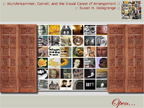When Revision Is Redesign: Key Questions for Digital Scholarship
Susan H. Delagrange
Reflection
Q: What can be gained from intensive reflection on the design and redesign of interactive digital scholarship?
Rhetoric is a techné, a productive art, and as such, its telos, or end, is outside itself. Just as the end of medicine is health, as judged by the patient; and the end of navigation is safe harbor, as judged by the passengers; so too the end of rhetoric is belief or persuasion, as judged by its audience.
I'm convinced of the importance of making as an epistemological act, the importance of visual and other kinds of evidence as necessary to a full and fruitful epistemic space, and the necessity of embodiment as an ethical condition of the making and the made.
As the writer/designer of this webtext, which reflects on the redesign of "Wunderkammer, Cornell, and the Visual Canon of Arrangement," I am my own first audience, and from my perspective, this reflection enriches both my practice and understanding of composing digital scholarship. Techné is a making, and involves knowledge in the hand and knowledge in the head. Knowledge in the hand comes from practice and experience, knowledge in the head from reflection on causes and effects; shaping this webtext helps me become a better, more aware practitioner of my visual/verbal/interactive art. While treated separately here, the categories I've discussed are always in play together in a productive oscillation of thinking and doing, making and remaking. It is also important to keep in mind that techné is neither intuitive nor innate. Because it encompasses the why as well as the how, it can be taught, and composing this reflective webtext helps me become a better teacher.
But this is a public reflection, and there are other contingencies to account for. What other contexts does it inhabit? What rhetorical situations does it respond to? Who are my public audiences?
One audience, of course, is other digital media scholars, both those who compose with digital media and those who take it as their field of study. The relationship between writing and visual design in envisioning and enacting argument is complex, and my hope is that these paired texts will help to demystify the digital composing process. I have always found it useful to get some insight into how other people take on the challenge of making meaning, and my focus on aspects of my redesign may cast some light on the larger intellectual project. On the other hand, digital media studies is an emerging field, and this reflection may also generate heat as part of the lively conversations that circulate over the place of new media work in the field of rhetoric and composition.
The other audience invoked by this project is those individuals, inside and outside the discipline, whose responsibility it is to evaluate the quality of digital scholarship. While the field matures, it will be up to us to make visible the rhetorical and intellectual work of scholarship in digital media, and to demonstrate how our work contributes to the larger humanities project. Reflections on our own scholarship, while they do not need to be as extended as this one, not only improve our own practice, but provide a context within which interactive digital media can be more productively read and viewed by our colleagues.
